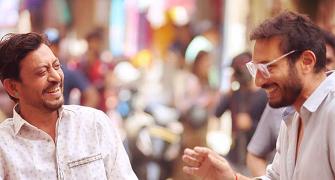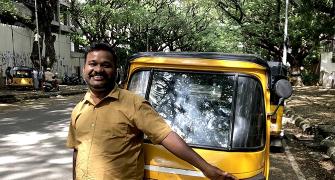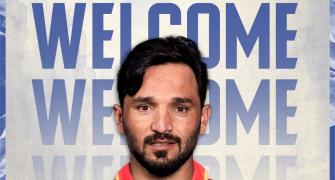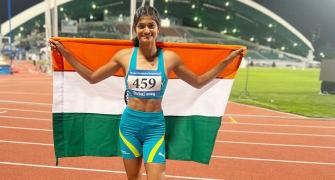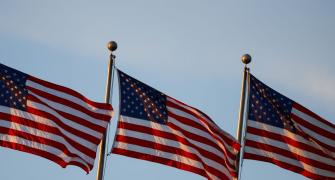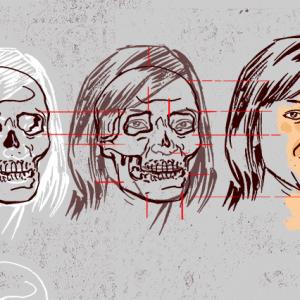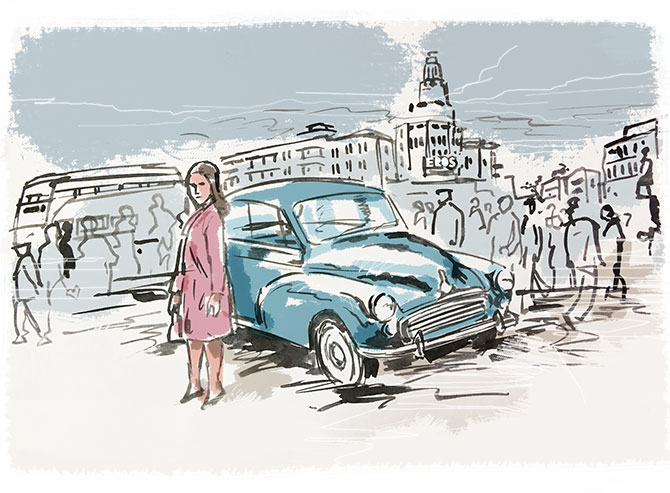The software had, perhaps unknown to Dr Tripathi, tracked the changes he had made.
The 'morph track' feature of the software provided a trail of what had been done and also indicated that the doctor had, it seemed, opted to morph Sheena's face with the provided skull, much in the same manner that Fantamorph can turn a woman into a cheetah.
Vaihayasi Pande Daniel reports from the Sheena Bora murder trial.
Illustration: Dominic Xavier/Rediff.com
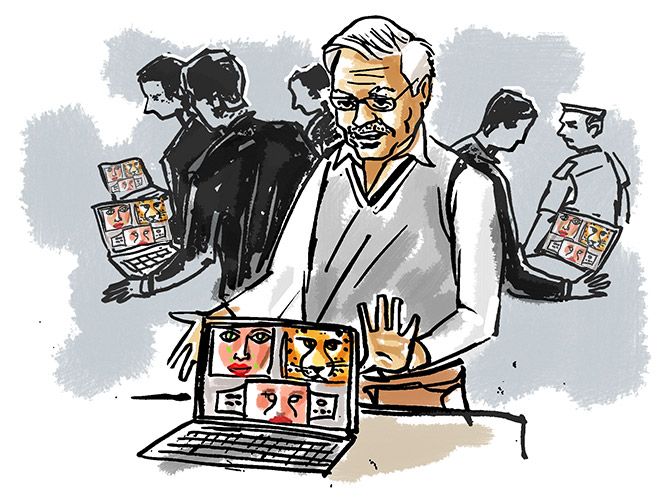
It was not easy to identify who exactly was in the witness stand being cross-examined, in the Mumbai city civil and session's Courtroom 51 in the Sheena Bora murder trial from Tuesday, January 7 to Thursday January 9, 2019.
Was it forensic medicine expert Dr Sunil Tripathi? The man who had ostensibly used his expertise to conclude, through the craniofacial superimposition technique, that the recovered skull matched Sheena's photographs?
Or was it Abrosoft's Fantamorph?
Was Dr Tripathi giving evidence?
Or Fantamorph?
Who had done the work? The software? Or the doctor? Someone else?
Or maybe Dr Tripathi was only as good as the software he had preferred.
That is also the interesting function of a witness box.
A person who enters it initially projects to the court a certain uncomplicated sometimes endearing view of himself/herself.
But the person exiting the box, post his cross-examination --- like the very software under discussion this week, whose test case ironically shows a pretty girl evolving into a cheetah -- has morphed into someone else entirely, revealing several more far too complicated layers to their personality.
So it was with Dr Tripathi.
When the good doctor entered the box last week, he was a forensic specialist, expert witness and seemed to be "a sweet, sincere old man", as someone put it.
After three days of rather efficient drubbing by both Indrani and Peter Mukerjea's lawyers Sudeep Pasbola and Shrikant Shivade, one wasn't quite sure who Dr Tripathi even was.
Certainly, there was a lot more to him than met the eye.
The software, Fantamorph, which had occupied the box along with Dr Tripathi, often aggressively nudging him out, so he literally didn't have a leg to stand on, didn't fare too well either, with Shivade at one point, in anger, denouncing it as "stupid software!"
Dr Tripathi retaliated hurt with: "Don't make personal remarks", as if Fantamorph was an extension of himself.
To quickly recap: Dr Tripathi, 72, had been called in from BHU, Varanasi, by the CBI to meet forensic doctors at the All India Institute of Medical Sciences, Delhi, who were examining Sheena's skull in 2015.
Dr Tripathi, who had some experience under his belt in conducting traditional craniofacial superimpositions, was tasked with comparing Sheena's photographs with the skull said to be Sheena's, found in in Raigad district and proving a match as per this technique.
The doctor, instead of utilising the skill he had trained in, which involves measurements and working with both black-and-white negatives/positives of pictures of the victim and the skull and placing them one on top of the other to show congruence, for this crucial examination opted to use Fantamorph.
Dr Tripathi's decision to use the software, and the software itself, took a battering from the defence because:
1. It is not a professional software used for craniofacial superimpositions.
2. The results of this software have never been examined in a court case in India before, according to Shivade, who told the judge with a laugh, "This should be the first and last time there will be a cross-examination on this Fantamorh!"
3. It was not particularly clear what Dr Tripathi had used the software for -- for superimposition or by some error, deliberate or unintentional, for morphing.
4. While the results the software produced could be manipulated, the work of the software did not really appear to require Dr Tripathi's expertise.
5. There seemed to be no proper justification for Dr Tripathi's decision to abandon his traditional methods (he said black-and-white film was no longer procurable although it is available on Amazon India for Rs 450 per roll) in favour of this software.
6. Craniofacial superimposition by traditional methods -- forget results from any weird-ass program called Fantamorh, its name a dead giveaway -- are not admissible in many courts, the world over, by themselves, Pasbola critically highlighted, though there had not been any ruling about it in the Indian Evidence Act and the judge said it could be brought in under this Act.
Pasbola began his 'cross' methodically on Tuesday dissecting the traditional method. And also who was the CBI personnel the doctor had liaised with.
Dr Tripathi, oddly, had no memory of who he had dealt with in the CBI.
The recounting of the steps involved in the traditional method of superimposition took off in court in a painful start-stop fashion.
Dr Tripathi's cross-examination, right from the word go, was a truly exhausting exercise.
That was why it lasted three days, between two lawyers.
There was no question put to the doctor that he was willing to give a yes/no or simple answer to.
A desire to engage in one-upmanship and his non-stop lecture mode ensured that each Q-and-A was a long-winded affair that tried the tempers of the lawyers and CBI Special Judge Jayendra Chandrasen Jagdale's patience.
After more than six-seven hours of this round-and-round, one began to suspect if the confused answers weren't some kind of smokescreen. And not so artless. Or guileless.
Pasbola went on subsequently to understand from Dr Tripathi what kind of facial landmarks needed congruence for a match.
They went through a list of landmarks (glabella, nasion, endocanthion, ectocanthion, rhinion, subnasale, gonion, zygion etc -- they are all on your face, folks). Pasbola enquired why these exact specifics were not in his final report.
The report lacked sufficient details on why Dr Tripathi had reached his conclusion that skull and photos were a perfect match. Dr Tripathi shrugged and said he had not mentioned the facts behind his reasons.
Pasbola checked whether Dr Tripathi had cropped any of the photographs while working on them and if that reduced the quality of the pictures.
Dr Tripathi agreed he had cropped them, but point-black refused to acknowledge it had any effect on the quality or graininess or blurring of the pictures.
"Jo characters hai woh toh rahti hai, woh diminish nahin hoti hai (facial characters remain visible and do not diminish). That remains. Aap mere ko dictate nahin kar sakte. Mein jo bol raha scientifically keh rahein hai. Grains hamesha appear nahin hoti hai (You can't dictate to me. I am saying this scientifically. Grains don't always come)!"
A large discussion unwound on how the doctor had come to all his deductions about the match of teeth between the skull and the photographs, when 1. the teeth were mostly only partially or barely visible in the photographs of Sheena 2. There were often prominent differences between the alignment of teeth of the skull and Sheena’s pics. And why hadn’t he taken the help of a forensic odontologist.
Dr Tripathi: "All persons have gaps in their teeth. Nothing individual about it. Individual-to-individual it varies."
Finally, Pasbola wondered why Dr Tripathi had chosen a "recreational" software that "was not a scientific tool" for this mission and why he was not a licensed user of it.
A little musical trill erupted at the back of the courtroom with that question. Indrani was in splits. Sanjeev Khanna also gave a broad smile.
The doctor firstly said he did not know what recreational meant. Nor that the software was recreational. Or if it could be legitimately used for a complicated process like superimposition.
At the end of his cross examination Pasbola told off Dr Tripathi: "I put it to you that your opinion is erroneous (Tripathi asked for a translation of the word erroneous). You have just done it to oblige the CBI. It is totally amateurish and not befitting of scientific standards."
Tripathi naturally disagreed and told Pasbola, as he was leaving the courtroom that lawyers were like "bal se jo khal nikalne wallah jo hote hai (like those people who find lice in the hair)."
By the time Pasbola finished on Tuesday it was four.
Shivade's cross examination began 11 am Wednesday. He arrived armed with a textbook titled Forensic Analysis of the Skull by M K Iscan, who Dr Tripathi had spoken about in reverent tones in his testimony.
Strangely, Dr Tripathi was not particularly familiar with the material in the book or the theories it expounded, casting further doubts on his earlier statement.
Shivade, on the road to becoming a doppelganger of Iscan, must have spent many days mastering craniofacial superimposition, had also turned himself, he said overnight, into a Fantamorh whiz and began to tackle Dr Tripathi head-on on details of a software that turned girls into cheetahs with the click of a few buttons.
The lawyer's cross, which plodded along inexorably, over two days, on an obsessively-structured path was gruelling but finally towards the end achieved flamboyant results.
Shivade's technique/finesse invariably combines deep study with detailed, arduous courtroom analysis, that ultimately corners a witness, even an expert one -- at the end he had Dr Tripathi shaking with anger.
At the beginning of his cross the lawyer uncovered the fact that 1. Dr Tripathi said he did not know the meaning of the innocuous English word logistics, but 2. Had agreed to an arrangement with CBI where they provided the 'logistics' (as per a letter he signed) during his visit to AIIMS although 3. They finally never provided any logistical help even when 4. Dr Tripathi had asked for the facility of a dark lab for doing traditional craniofacial superimpositions which led to 5. The doctor's decision to use the wretched Fantamorph.
Shivade delved into minute details of how the skull was handed over to Dr Tripathi and whether he had worked alone.
Dr Tripathi had been handed the skull and the mandible from a carton of bones at AIIMS. There were no checks and balances in place for formally receiving the human remains (no signing, register entries etc) or effectively any proof of which skull Dr Tripathi had worked on because there had been no marking (numbering) either on the skull or visible in the photographs of the skull he used while undertaking superimposition.
So was it Sheena's skull even?
Shivade lambasted the doctor for not observing a chain of custody as was procedurally required while handling remains.
Dr Tripathi insisted that since he was working within the confines of the AIIMS's forensic medicine department it was not required -- "Mein udhar hi the, kahin ja nahin re the."
The doctor had been handed a mandible and skull to work on.
But his photographs, which he took, were of a skull standing erect with the jaw attached.
Shivade wondered -- given the vital importance of the tilt of a skull and the size of the face in producing accurate results -- how had Dr Tripathi achieved that?
Had he glued the mandible to the skull? How had he stood the skull up? Had he used a stand?
Dr Tripathi denied using glue -- "chipkaya nahin tha."
Shivade cornering him, irate: "Did you join the skull and mandible by cellotape, nails, Fevicol?"
He finally admitted he used "multiple folded papers" to hold the mandible into the skull. And since he had no stand he had utilised putty.
Neither, as per textbook requirements, were legitimate methods, Shivade pointed out.
Dr Tripathi: "At AIIMS such device (skull stand) was not available."
Shivade, angrily: "Nahin rahega toh aap innocent ko andar nahin kar sakte hai (If it isn't there, you can't imprison an innocent person)."
Shivade next zoomed in, mercilessly, on Dr Tripathi's use of trial software, that was neither registered nor paid for.
How had he got to know about the software in 2004?
How had he perfected his knowledge of the software?
Since trial software expired every 30 days, how many times had he downloaded it?
The answers to these questions reconstructed before the court a scenario that was tragi-comical.
Dr Tripathi first said he had received the software from a friend.
On being pressed for more details, he admitted his daughter Divaa had sent it to him.
He said he had spent four-five years perfecting his ability to manipulate Fantamorph -- "I got command."
Shivade commented "Such a lot of time was required. I learned it in a day." Khalee button dabana hai! (all you need to do is press a button!)"
But he had never put his skills to test till the Sheena Bora case came along.
Since he had not bought the software, he re-downloaded it, when each trial period came to an end, on another machine.
Shivade: "Das saal chalaya?! (You used it for 10 years?!) On one computer then the next?"
Dr Tripathi: "Char-panch baar kiya hoga (did it four-five times)."
Shivade: "So 150 days total usage. Khatam kab hua? (When did you finish?)"
Dr Tripathi: "Jab perfection aa gaya (When I reached perfection)."
Shivade also questioned Dr Tripathi on his reasoning for choosing the four photographs of Sheena that he did, among the several provided by the CBI, given that in one of them her face was masked by sun glasses and in another hair obscured a lot of the face. And in all the results were further disturbed by the watermark of the program (since it had not been purchased).
Towards the end of his cross, Shivade spent an hour or two working with Dr Tripathi, each on their respective laptops, going over every minute detail with him on how the software worked (at what point the seductive-looking girl became half a cheetah and then a full cheetah) and why certain abnormal variations could be observed between Sheena's photos and the skull superimposed on it (or vice versa).
There were several laptops, belonging to various defence lawyers and the court, on in the courtroom, all open to the girl and the cheetah Fantamorph screen, tracking Shivade's progress.
Another one of those tiresome arguments ensued when Dr Tripathi insisted that at the 50% mark of the software the girl was not half-cheetah.
At points the doctor's obstinance or his tendency to take the Q&A down some meandering garden path where he prattled on irrelevantly on some other topic would get Shivade so riled up that he would explode.
"I can cross-examine you for one week if the court permits. Dialogue nahin chahiye!"
The last hour of Shivade's 'cross' was crucial.
During the process of comparing Sheena's photos with skull photos, Shivade pointed out, area by area, set by set, where the skull line exceeded the faceline.
That could not be because a faceline is always larger than its corresponding skull line since a live face has soft tissue on it and hair around it.
Dr Tripathi put it down to enlargement and something else unintelligible.
Lastly, Shivade explored the possibility of manipulation of the software. If superimposition involved the matching of facial landmarks that was done by way of dots, was it possible to move the dots to get a suitable result.
Dr Tripathi vigorously denied knowing how to move the dots or any deeper technological knowledge of Fantamorph.
In a final triumphant crescendo to this drama playing out in Courtroom 51 the lawyer demonstrated physically to the doctor that he had moved the dots to make sure he got the result required.
The software had, perhaps unknown to Dr Tripathi, tracked the changes he had made.
The 'morph track' feature of the software provided a trail of what had been done and also indicated that the forensic doctor had, it seemed, opted to morph (no superimposition involved here) Sheena's face with the provided skull, much in the same manner that Fantamorph can turn a woman into a cheetah or say Donald Trump into Boris Johnson (download Fantamorph and try it yourself).
That didn't go down well at all with Dr Tripathi who lost it at various points and started yelling: "One objection is there. I am not an expert in technology. Questions pertaining to technology cannot be asked. I will not give an answer on that! Finished!"
It was a rather victorious Shivade who departed court on Thursday after declaring to Dr Tripathi: "Doctor Sahib I put it to you that this entire exercise of using Fantamorph software has been designed by you and the CBI and the tampering has been caught on morph track... You are a handpicked expert of the CBI! The entire evidence given by you is false."
The trial resumes on Tuesday, January 14 with yet another medical expert, who hopefully does not have a penchant for software.
Vaihayasi Pande Daniel covers the Sheena Bora Murder Trial for Rediff.com.
You can read her fascinating coverage here.

